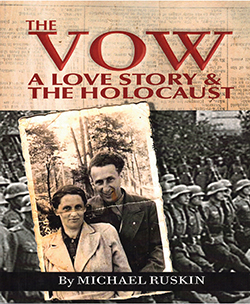The Vow: A Love Story & The Holocaust by Michael Ruskin; Booklogix © 2021; ISBN 9781639-720743; 169 pages including afterword, timeline, and appendices; $24.

 SAN DIEGO – In Kaunas, Lithuania, a city also known as Kovno, David and Dora Ruskin married in 1938. They had a daughter, Rose Miriam, in 1939, and came under Nazi German occupation in 1941. After three years under horrific ghetto conditions, with regular roundups of people to be sent to death camps, including their little daughter, David and Dora were deported in June, 1944, to separate concentration camps. He was shipped to Dachau, Germany; she was transported to Stutthof, Poland.
SAN DIEGO – In Kaunas, Lithuania, a city also known as Kovno, David and Dora Ruskin married in 1938. They had a daughter, Rose Miriam, in 1939, and came under Nazi German occupation in 1941. After three years under horrific ghetto conditions, with regular roundups of people to be sent to death camps, including their little daughter, David and Dora were deported in June, 1944, to separate concentration camps. He was shipped to Dachau, Germany; she was transported to Stutthof, Poland.
Before being herded onto separate trains, the couple made a vow that they would meet each other back in the main square in Kaunas whenever they should be liberated.
Dora and her sister Sara were required to dig anti-tank ditches which the Nazis hoped could stop or slow their Russian enemies. When it became clear that the Russians would capture the concentration camp, the women were forced with other inmates to make a 26-mile death march through freezing temperatures to the Baltic Sea. Dora and Sara were on the verge of being shot because they were too exhausted to go farther when Russian soldiers intercepted the marchers and killed 12 Nazi guards.
David, meanwhile, wworked as a forced laborer at an aircraft plant just outside the Dachau camp. As U.S. forces approached, David and other inmates were forced to march to the south towards the German-Austrian border. Like Dora, David and his fellow prisoners were rescued by opposing military forces – in this case American GIs from the 522 Field Artillery Battalion.
Dora and David were sent to recuperate at different displaced person’s camps. Recovering first, David decided to walk and hitchhike on a circuitous route toward Kaunas from Dachau, while making it a point to stop at every DP camp en route just in case he should find Dora at one of them. He passed through numerous camps without luck, growing more weary, yet optimistic, the closer he got to Kaunas.
At a DP camp in Lodz, Poland, David saw a man who had been his neighbor in Lithuania. The neighbor said he had seen both Sara and Dora earlier that day, heading for the infirmary. His spirits renewed, and his body no doubt pumping with adrenalin, David ran to the infirmary, where he found Sara in good health but his wife Dora suffering with typhus. She had a high fever, was severely dehydrated, and fell in and out of consciousness. When she first saw David, she asked if she was now in heaven.
David was able to get her into a doctor’s car and take Dora to a hospital where her life hung in the balance for several days. But eventually, with good care, she rallied. The couple was able to relocate to a DP camp in Foehrenwald, Germany, where Dora set up a school system for the children – an accomplishment for which she was honored in 1946 at a ceremony that General Dwight D. Eisenhower, the future U.S. President, attended. That same year, the couple’s oldest son Allen was born.
From David’s relatives came an invitation to settle in Johannesburg, South Africa, and from Dora’s came another invitation to settle in Brooklyn. The couple chose to go to the United States, where another son, Michael, author of this book, was born.
The couple’s Holocaust experiences are well documented and public-domain photos provide visual representations of experiences similar to those that the Ruskin family endured. For new generations, just learning about the Holocaust, this volume will be a good introduction.
*
Donald H. Harrison is editor emeritus of San Diego Jewish World. He may be contacted via donald.harrison@sdjewishworld.com